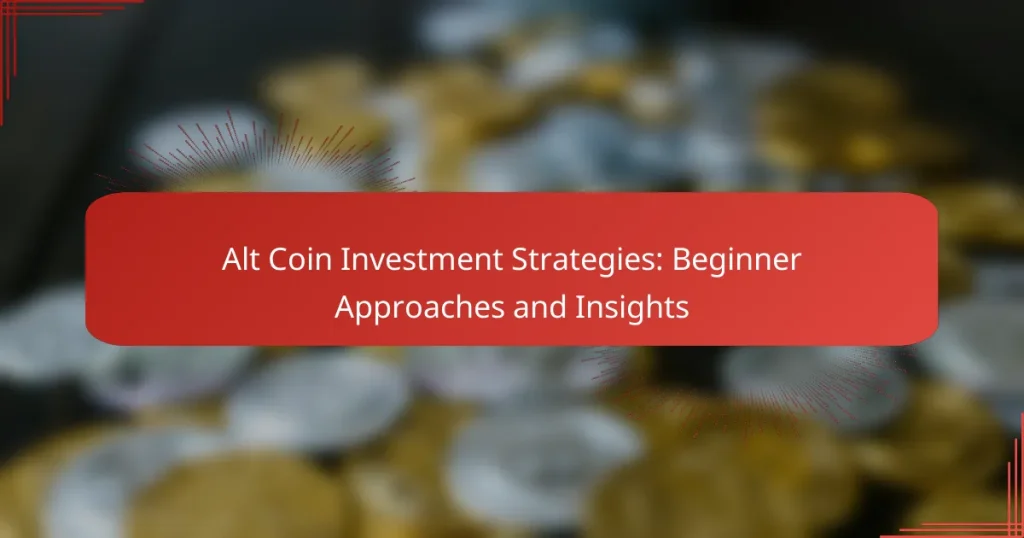Investing in altcoins can be a rewarding venture for beginners, but it requires a strategic approach to minimize risks and maximize returns. By employing techniques such as dollar-cost averaging and portfolio diversification, along with thorough research and community engagement, new investors can navigate the complexities of the altcoin market more effectively. Understanding key factors like market capitalization and project fundamentals is essential for identifying promising opportunities while being mindful of the inherent risks involved.

What are effective altcoin investment strategies for beginners?
Effective altcoin investment strategies for beginners focus on minimizing risk while maximizing potential returns. Key approaches include dollar-cost averaging, portfolio diversification, thorough research, utilizing reputable exchanges, and engaging with the community.
Dollar-cost averaging
Dollar-cost averaging (DCA) involves investing a fixed amount of money into altcoins at regular intervals, regardless of their price. This strategy helps reduce the impact of volatility, as it allows you to buy more coins when prices are low and fewer when prices are high.
For example, if you invest $100 monthly, you will accumulate more coins during market dips, averaging out your purchase price over time. This method is particularly useful for beginners who may be uncertain about market timing.
Portfolio diversification
Portfolio diversification means spreading your investments across various altcoins to reduce risk. By not putting all your funds into a single coin, you can protect yourself from significant losses if one asset underperforms.
A balanced portfolio might include a mix of established coins and promising newcomers. Aim for a mix of different sectors within the crypto market, such as DeFi, NFTs, and utility tokens, to further mitigate risk.
Researching altcoin fundamentals
Understanding the fundamentals of altcoins is crucial for making informed investment decisions. This includes examining the project’s whitepaper, the team behind it, its use case, and market demand.
Look for coins with strong community support, active development, and clear roadmaps. Websites like CoinMarketCap and CoinGecko can provide valuable insights into market trends and performance metrics.
Utilizing crypto exchanges like Binance
Using reputable crypto exchanges like Binance can enhance your trading experience and security. These platforms often offer a wide variety of altcoins, advanced trading features, and educational resources for beginners.
Ensure you understand the fee structure and security measures of the exchange you choose. Consider starting with small trades to familiarize yourself with the platform before making larger investments.
Engaging in community discussions
Participating in community discussions can provide valuable insights and updates about altcoins. Platforms like Reddit, Telegram, and Discord host active communities where investors share knowledge and experiences.
Engagement in these forums can help you stay informed about market trends, upcoming projects, and potential risks. However, be cautious of misinformation and always verify claims before acting on them.

How to choose the right altcoins to invest in?
Choosing the right altcoins involves evaluating various factors such as market capitalization, project fundamentals, team expertise, and community sentiment. A well-rounded approach can help mitigate risks and identify promising investment opportunities.
Assessing market capitalization
Market capitalization is a crucial metric that indicates the total value of an altcoin. It is calculated by multiplying the current price by the circulating supply of coins. Generally, altcoins with higher market caps are considered more stable, while those with lower caps may offer higher growth potential but come with increased risk.
When assessing market cap, consider categorizing altcoins into three tiers: large-cap (over $10 billion), mid-cap ($1 billion to $10 billion), and small-cap (under $1 billion). This classification can guide your investment strategy based on your risk tolerance and investment goals.
Evaluating project whitepapers
A project’s whitepaper serves as its blueprint, outlining its purpose, technology, and roadmap. A well-written whitepaper should clearly explain the problem the project aims to solve, its unique value proposition, and the technology behind it. Look for transparency and thoroughness in the documentation.
When reviewing a whitepaper, check for realistic timelines and achievable milestones. Projects that promise quick returns or overly ambitious goals may be red flags. Additionally, assess the tokenomics, including the distribution model and utility of the token within the ecosystem.
Analyzing team credentials
The expertise and background of a project’s team can significantly impact its success. Research the team members’ previous experience in blockchain, technology, and business. Strong teams often have a track record of successful projects or relevant industry experience.
Consider looking for team members who are active in the cryptocurrency community and have established reputations. LinkedIn profiles, past project involvement, and public engagements can provide insights into their credibility and capabilities.
Monitoring social media sentiment
Social media sentiment can provide valuable insights into public perception and community engagement surrounding an altcoin. Platforms like Twitter, Reddit, and Telegram often serve as hubs for discussions, news, and updates. Monitoring these channels can help gauge investor sentiment and potential market movements.
Use tools to analyze sentiment trends over time, focusing on the volume of positive versus negative mentions. However, be cautious of hype and misinformation; always cross-reference information with credible sources before making investment decisions.

What are the risks associated with altcoin investments?
Altcoin investments carry several risks that potential investors should be aware of, including market volatility, regulatory uncertainties, security vulnerabilities, and liquidity challenges. Understanding these risks can help investors make informed decisions and manage their portfolios more effectively.
Market volatility
Market volatility is a significant risk in altcoin investments, as prices can fluctuate dramatically within short periods. This volatility can be driven by factors such as market sentiment, news events, and trading volumes, leading to potential gains or losses that can reach double-digit percentages in a single day.
Investors should be prepared for these price swings and consider using stop-loss orders to limit potential losses. Additionally, diversifying across multiple altcoins may help mitigate the impact of volatility on an overall portfolio.
Regulatory uncertainties
Regulatory uncertainties pose a notable risk for altcoin investors, as governments worldwide are still developing frameworks to govern cryptocurrencies. Changes in regulations can affect the legality and usability of specific altcoins, leading to sudden price drops or increased scrutiny.
Investors should stay informed about the regulatory landscape in their country and consider how potential changes could impact their investments. Engaging with reputable sources and following news updates can provide valuable insights into evolving regulations.
Security vulnerabilities
Security vulnerabilities are a critical concern for altcoin investors, as many altcoins are susceptible to hacking and fraud. Weaknesses in smart contracts, exchanges, or wallets can lead to significant financial losses if exploited.
To protect investments, it is essential to use secure wallets, enable two-factor authentication, and conduct thorough research on the security measures of exchanges before trading. Investors should also be cautious of phishing scams and only interact with trusted platforms.
Liquidity challenges
Liquidity challenges can affect altcoin investments, as some altcoins may not have sufficient trading volume to facilitate easy buying or selling. Low liquidity can lead to higher price volatility and difficulty executing trades at desired prices.
Investors should assess the trading volume of altcoins before investing and consider focusing on those with higher liquidity to ensure smoother transactions. Utilizing limit orders can also help manage trades in less liquid markets effectively.

What tools can assist in altcoin investment?
Several tools can enhance your altcoin investment strategy by providing essential data, automating trades, and managing your portfolio effectively. Utilizing these resources can help you make informed decisions and streamline your investment process.
Using CoinMarketCap for tracking
CoinMarketCap is a widely used platform for tracking the performance of altcoins. It provides real-time data on prices, market capitalization, trading volume, and historical performance, allowing investors to compare different cryptocurrencies easily.
To effectively use CoinMarketCap, focus on key metrics such as price changes over 24 hours, market cap rankings, and trading volume. This information can help you identify trends and make timely investment decisions. Regularly checking the site can keep you updated on market shifts.
Employing trading bots like 3Commas
Trading bots, such as 3Commas, automate trading strategies to optimize your altcoin investments. These bots can execute trades based on predefined conditions, helping you capitalize on market fluctuations without constant monitoring.
When using 3Commas, set clear parameters for your trading strategy, including stop-loss and take-profit levels. This approach minimizes emotional trading and can lead to more disciplined investment practices. Be cautious of over-relying on bots; regular oversight is still necessary.
Utilizing portfolio management apps
Portfolio management apps help you track and manage your altcoin investments in one place. These tools provide insights into your overall portfolio performance, asset allocation, and profit/loss calculations, making it easier to assess your investment strategy.
Popular apps like Blockfolio or Delta allow you to sync your exchange accounts for real-time updates. When using these apps, regularly review your portfolio to ensure it aligns with your investment goals and risk tolerance. Avoid neglecting underperforming assets; consider rebalancing as needed.

How to set investment goals for altcoins?
Setting investment goals for altcoins involves defining what you want to achieve with your investments, such as capital appreciation, income generation, or diversification. Clear goals help guide your investment strategy and decision-making process.
Defining risk tolerance
Risk tolerance refers to your ability and willingness to endure fluctuations in your investment’s value. Assessing your risk tolerance involves considering your financial situation, investment experience, and emotional comfort with potential losses. A common approach is to categorize yourself as conservative, moderate, or aggressive based on how much volatility you can handle.
For example, if you can afford to lose a significant portion of your investment without impacting your lifestyle, you might lean towards a more aggressive strategy. Conversely, if you need to preserve your capital for short-term needs, a conservative approach may be more suitable.
Establishing time horizons
Your time horizon is the period you plan to hold your altcoin investments before needing to access your funds. Short-term horizons typically range from a few months to a couple of years, while long-term horizons can extend beyond five years. Understanding your time frame is crucial as it influences your investment choices and risk exposure.
For instance, if you aim to invest for retirement in 10 years, you might be more inclined to select altcoins with strong growth potential, accepting higher volatility. In contrast, if you need funds for a major purchase in the next year, you might prioritize more stable options.
Setting profit-taking strategies
Profit-taking strategies involve determining when to sell your altcoins to realize gains. Establishing clear criteria for taking profits helps prevent emotional decision-making and ensures you capitalize on favorable market conditions. Common strategies include setting target prices or using trailing stops to lock in profits as prices rise.
For example, you might decide to sell 50% of your holdings once an altcoin reaches a specific price target, while allowing the remaining portion to ride the market. Alternatively, you could set a trailing stop at 10% below the highest price achieved, automatically selling if the price drops significantly.


